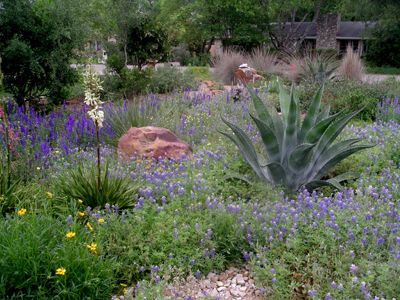by Larry
December, 2012One's Own Natural HabitatThe NWF's answer to all those sweaty weekends trying to manage a monoculture turf? Create a natural habitat instead. It is relatively easy, can be fun for adults and kids alike, is super for the environment, makes for many more sightings of neat critters, and often has more aesthetic appeal than a manicured grass carpet. Here are five simple directions toward making one's own natural habitat: 1. To provide food for the creatures who will visit or live in your natural area, select and place in the ground plenty of native flora. Plants which are variously well adapted to cold and warm, dry, and wet phases of the region should do nicely and will provide for animals' nutritional requirements. Local nurseries and native plant societies can give valuable tips. Herbs, vegetables, abundant and diverse flowering plants, many grass types, vines, thistles, fruiting or seed-bearing shrubs, nutty trees, and so forth may productively make up one's natural habitat. Some creatures will eat others, of course, but the biosphere depends most basically on its plant food sources.
2. Provide moderate water supplies for both vegetation and wildlife. Depending on how large the habitat will be, one or more birdbaths, streams, hollows in rocks that can either catch rainwater or hold moisture provided from a hose, or small ponds might serve the liquid needs of your natural space's fauna. 3. Give thought to your animal guests' requirements for cover. Large or little, adult and young, creatures in one's habitat will need places where they can be safe from predators. Most people think of animals preferring to be screened off at times by plants near the ground or in tree canopies. Yet they also require cover between low and high environments. To blend in, they can benefit too from a variety of different colors in the habitat's foliage. Birdhouses and brush piles are obvious enhancements of natural cover. For critters smaller than birds, so are rocks, leaves, and dead branches left in place on or near the ground. Shrubs and grasses that grow high can help offer cover in mid-height ranges. 4. Maintain the habitat space in eco-friendly ways. Avoid spraying or dusting with pesticides and fertilizers. Instead of leaving them in one's habitat space, properly dispose of environmental hazards like old paint or tar cans, oil containers, bleach and ammonia bottles, etc. Clean water receptacles periodically to help prevent diseases among your wildlife. Find ways to avoid needing to provide artificial watering. Rain barrels and distribution arrangements, mulch bins, and drought-hearty plants may be handy toward this end. A smaller lawn, surrounded by more natural garden areas is better. Little or even no mowing areas are best. If one does still need to cut the grass, consider using a reel mower instead of a power one, to cut down on noise and other kinds of pollution. Less interference with the setting means it will be more attractive for different kinds and larger numbers of wildlife. 5. Once your natural habitat is established, think about getting it certified by the National Wildlife Federation. This will encourage you to keep that space more consistent with your plants' and animals' needs, will help promote the natural habitat movement, can aid in getting the kids engaged, and might offer others a place to go to see how folks before them have managed to kick the lawn habit, by fashioning a habitat instead. Valerie and I at times envy our friends and relatives who possess much larger spreads than we. However, by encouraging the plants and animals to thrive in our postage stamp of a natural habitat, we also have much to appreciate once we merely step out of doors. Diminutive as it is, and though surrounded by roads, other dwellings, plus a high privacy fence in back, into our one-third of an acre, only about half not covered by the house, walks, or driveway pavement, have over the years come quite a mixture of entertaining fauna (of which we know), including skunks, opossums, a duck, toads, snakes, a rabbit, mice, anoles, rats, mosquito fish, grackles, doves, owls, geckos, fence and spiny lizards, hawks, squirrels, robins, blue jays, sparrows, and even a young porcupine, not to mention a whole other world of smaller critters such as walking sticks, wasps, butterflies and their caterpillars, crickets, bees, mites, mayflies, ants, flies, moths, aphids, dragonflies, termites, cicadas, snails, spiders, ox beetles, slugs, true bugs, scorpions, and on and on. We consider all these marvels of nature rather cool and believe you will too, with your own natural habitats. Primary sources: -Make Your Backyard a Certified Wildlife Habitat in 5 Steps. Summer Minor in Family and Parenting Magazine; February 8, 2010. -How to Create a Backyard Wildlife Habitat. Jessika Toothman in TLC - A Discovery Company; December 16, 2008. |
